Local News
Donlands station now accessible, but full TTC subway system could take at least 2 more years

The TTC held an opening ceremony to mark Donlands station becoming an accessible facility, but after decades of work to make the subway network barrier-free it’s expected to take at least two more years to finish the job.
Dignitaries held a ribbon-cutting ceremony at the station Wednesday afternoon to mark the completion of installing elevators that operate between street level and platform level, sliding doors, tactile wayfinding and increased signage.
The station building on the west side of Donlands Avenue just north of Danforth Avenue had to be expanded to accommodate the elevator that services the eastbound Line 2 Bloor-Danforth platform. A secondary entrance on Dewhurst Boulevard was also added.
“This moment is an important step forward in ensuring every customer, regardless of physical ability, can navigate our city’s transit system with ease, dignity and independence,” Betty Rivington-Law, co-vice-chair of the TTC Advisory Committee on Accessible Transit (ACAT), said during the ceremony.
“However, for far too long, many individuals — especially individuals with mobility challenges, seniors and parents with strollers — have faced barriers that limit their ability to use transit reliably. Today we break down one of those barriers.”
Donlands became the 55th accessible TTC subway station, and later in 2024, Castle Frank and Glencairn stations are expected to also become barrier-free.
While work to make the subway system accessible began in 1990, efforts ramped up after the Ontario government enacted the Accessibility for Ontarians with Disabilities (AODA) Act in 2005. When it became law, it mandated that all major services and facilities become accessible by Jan. 1.
The TTC fleet of buses, streetcars and subway trains are accessible, but work to make many of the facilities the vehicles operate in barrier-free is ongoing.
Based on a 2023 TTC board report, the remaining subway stations all have seen construction-related delays. Donlands was supposed to be done a year earlier while Castle Frank and Glencairn stations are months behind.
At the time, eight stations were set to see accessibility upgrades completed in 2025: Summerhill, Greenwood, Rosedale, College, Lawrence, Christie and Museum.
King station, which was set to be done by the end of 2024, has been pushed back by two years. The addition of barrier-free upgrades at Warden and Islington stations are tied to broader redevelopment projects and are expected to be in place in 2026.
Meanwhile, land expropriation issues have bogged down plans to upgrade Old Mill station. The report didn’t have a projected opening time.
Since all of the stations won’t be fully accessible, the TTC’s staff have been working on an interim plan to meet the AODA timeline and it will likely involve using buses to take riders to barrier-free stations.
During Wednesday’s event, The Leader Spirit asked officials about the delays in making the entire TTC subway system accessible.
Greg Percy, the TTC’s new interim CEO, said with many decades-old stations, accessibility wasn’t at the forefront of planning.
“It is now,” he said.
“We’re shoehorning in the accessible features whether it’s secondary access, elevators, whatever it is depending on the station because you have to custom-design, custom-build accessibility into a given station, so it does take time.”
Percy said the TTC “prioritized funding over time” and money wasn’t an issue. He added the complexity of projects at certain stations and the availability of contractors also factored into delays.
“It’s easy to buy new buses that are accessible, it’s easy to buy streetcars that are accessible … but it’s not so easy to take an existing station and the tracks, and you can’t close the station down and do the work. You have to do it around it,” Ward 14 Toronto-Danforth Coun. Paula Fletcher added.
“Technically, it’s a very different job than making other parts of the TTC accessible … we’d like it to go faster, this is how it’s going.”
TTC needs to improve existing accessibility features, expedite improvements: advocate
While much of the overall TTC system is accessible for riders, that doesn’t always make it easier for persons with disabilities.
Terri-Lynn Langdon is a transit advocate in Toronto and uses a wheelchair for mobility. She told The Leader Spirit she uses streetcars and subways almost daily to go to appointments and social outings.
“The TTC is as vital to myself and the disability community as it is to anyone else,” Langdon said.
“The TTC continues to say that their system is accessible and this is incredibly problematic. We need to change the language so that the TTC is really focused on making improvements to a lack of access.”
The Leader Spirit met with Langdon at Queen’s Park subway station on Wednesday to better understand the issues she faces when commuting. College station is closest to where she lives, but it’s not accessible.
While taking one of two elevator trips down to the platform level from College Street, Langdon emphasized the need for regular elevator maintenance to prevent outages since that has been an issue in the past.
“If this elevator breaks down, it doesn’t matter if there are two accessible entrances because this is the way you get up and down into the subway,” she noted.
As trains passed by and under a tunnel with many of the decorative panels removed, Langdon took The Leader Spirit along the entire length of a platform. She pointed out several edges that have been chipped away due to wear and tear.
“That’s how I get stuck, that’s how some other transit users get stuck … and across time it just degrades,” Langdon said.
At the southern end of the southbound platform, construction hoarding reduced the width of space for people getting off a train. While an employee asked Langdon and The Leader Spirit to not stand in that area, she said there wasn’t a warning onboard the train and when she got off she said she had little room to manoeuvre.
The Leader Spirit contacted the TTC to ask about Queen’s Park station and in particular the broken yellow tiles. A spokesperson said they didn’t know if the issue was previously reported to transit agency staff, but they are now looking into the matter after The Leader Spirit raised it. They also encouraged people to contact customer service staff to report any potential safety- or accessibility-related concerns.
So as the transit agency continues to carry out its overhaul of subway stations, Langdon said the delays have left her and others frustrated.
“That makes me feel like people think that my transit needs and my access to the community counts for less, and a lot of people feel that way that have access barriers,” she said.
Meanwhile, Langdon argued the TTC shouldn’t pursue its “family of services” plan without a fully accessible conventional transit system being in place. The plan seeks to get many more Wheel-Trans users onto subways, streetcars and buses versus the current system.












